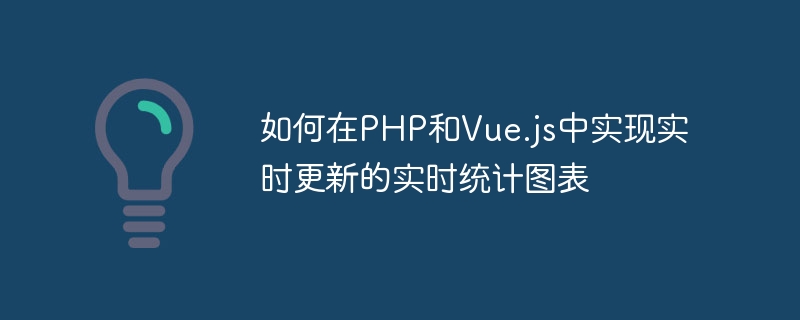Home >Backend Development >PHP Tutorial >How to implement real-time statistical charts with real-time updates in PHP and Vue.js
How to implement real-time statistical charts with real-time updates in PHP and Vue.js
- 王林Original
- 2023-08-17 09:30:141046browse

How to implement real-time updated statistical charts in PHP and Vue.js
Overview
With the continuous development of the Internet, the demand for real-time data is also increasing. Come more and more. Real-time statistical charts allow us to monitor data changes in real time and provide strong support for decision-making. This article will introduce how to use PHP and Vue.js to implement a real-time statistical chart that updates in real time.
Technology Stack
When implementing real-time updated statistical charts, PHP is responsible for the processing and transmission of background data, while Vue.js, as the front-end framework, is responsible for real-time rendering and updating of charts.
Steps
- Installing and Configuring WebSocket Service
The key to achieving real-time updates is to use WebSocket technology. We can use Ratchet to implement a simple WebSocket server. Execute the following command in the PHP project to install:
$ composer require cboden/ratchet
After the installation is complete, we can create a WebSocket server class, inherit Ratchet's WebSocketServerInterface, and implement methods such as onMessage, onOpen, and onClose. For specific implementation, please refer to Ratchet’s official documentation.
- Start and run the WebSocket service
You can start the WebSocket service in the entry file of the PHP project. When there is a new message, the message is pushed to the front end through WebSocket.
// 入口文件 index.php
use RatchetServerIoServer;
use MyWebSocketServer;
require dirname(__FILE__) . '/vendor/autoload.php';
$server = IoServer::factory(
new MyWebSocketServer(),
8080
);
$server->run();- Front-end page design
To use Vue.js to build a front-end page, you first need to introduce the Vue.js library and Chart.js (an excellent chart library). Then, define some initial chart data in thedataproperty of the Vue instance.
<!DOCTYPE html>
<html>
<head>
<title>实时统计图表</title>
<script src="https://cdn.jsdelivr.net/npm/vue/dist/vue.js"></script>
<script src="https://cdn.jsdelivr.net/npm/chart.js"></script>
</head>
<body>
<div id="app">
<canvas id="chart"></canvas>
</div>
<script>
new Vue({
el: "#app",
data: {
chartData: {
labels: [],
datasets: []
}
},
mounted() {
this.initChart();
this.listenWebSocket();
},
methods: {
initChart() {
// 使用Chart.js初始化图表
// 可以根据需要自定义图表的样式和数据
// 请参考Chart.js的官方文档
},
listenWebSocket() {
let socket = new WebSocket("ws://localhost:8080");
socket.onmessage = (event) => {
// 当有新的数据推送时,更新chartData
this.chartData.labels.push(event.data.label);
this.chartData.datasets.push({
label: event.data.label,
data: event.data.value
});
// 更新图表
this.updateChart();
};
},
updateChart() {
// 使用Chart.js更新图表
// 可以根据需要自定义图表的样式和数据
// 请参考Chart.js的官方文档
}
}
});
</script>
</body>
</html>- Backend data processing and push
After the WebSocket server receives the data, we need to process the data, and then push the data to the front end through WebSocket.
// MyWebSocketServer.php
use RatchetConnectionInterface;
use RatchetMessageComponentInterface;
class MyWebSocketServer implements MessageComponentInterface
{
protected $clients;
public function __construct()
{
$this->clients = new SplObjectStorage;
}
public function onOpen(ConnectionInterface $conn)
{
$this->clients->attach($conn);
}
public function onMessage(ConnectionInterface $from, $msg)
{
foreach ($this->clients as $client) {
if ($client !== $from) {
$client->send(json_encode([
'label' => $msg['label'],
'value' => $msg['value']
]));
}
}
}
public function onClose(ConnectionInterface $conn)
{
$this->clients->detach($conn);
}
public function onError(ConnectionInterface $conn, Exception $e)
{
$conn->close();
}
}- Conclusion
Through the above steps, we successfully implemented a real-time statistical chart that updates in real time. PHP is responsible for processing data and pushing, while Vue.js is responsible for rendering and updating charts in real time. This real-time data display method can be widely used in real-time monitoring, data analysis and other fields to provide timely and accurate data support for decision-making.
The above is the detailed content of How to implement real-time statistical charts with real-time updates in PHP and Vue.js. For more information, please follow other related articles on the PHP Chinese website!
Related articles
See more- Code example of WeChat applet modifying data to update page data in real time
- How does redis realize real-time page updates and automatic online updates?
- How to create high-performance MySQL data statistics charts using Go language
- How to implement the product sales statistics chart function in PHP Developer City

